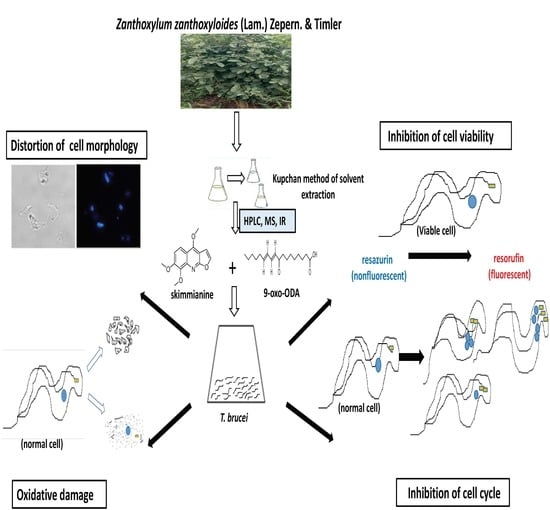Isolation and Antitrypanosomal Characterization of Furoquinoline and Oxylipin from Zanthoxylum zanthoxyloides
Abstract
:1. Introduction
2. Materials and Methods
2.1. Culture of Parasites and Mammalian Cell Lines
2.2. Crude Extraction and Fractionation of Plants
2.3. Chromatographic and Spectrometric Analysis
2.4. Analysis of Cell Viability and Cytotoxicity
2.5. Analysis of Cell Cycle
2.6. Fluorescence Microscopy
2.7. Antioxidant Potential Analysis
2.8. Antitrypanosomal Sensitivity Analysis
2.9. Statistical Analysis
3. Results
3.1. Bioactivity-Guided Chromatography, Spectrometry, and Spectroscopy of Compounds
3.2. Compounds 1 and 2 Were Selectively Antitrypanosomal
3.3. Compounds 1 and 2 Induced Cell Cycle Arrest in T. brucei
3.4. Compounds 1 and 2 Aggregated and Distorted Morphology and Distribution of T. brucei
3.5. Oxidant Capacity of Compounds in T. brucei
3.6. Effects of Compounds on Growth Kinetics of T. brucei
4. Discussion
5. Conclusions
Supplementary Materials
Author Contributions
Funding
Acknowledgments
Conflicts of Interest
Abbreviations
| AT | African trypanosomiasis |
| Z. zanthoxyloides | Zanthoxylum zanthoxyloides (Lam.) Zepern. and Timler |
| 9-oxo-ODA | 9-oxo-10, 12-octadecadienoic acid |
| PPARα | peroxisome proliferator-activated receptor alpha |
References
- Simarro, P.P.; Cecchi, G.; Franco, J.R.; Paone, M.; Diarra, A.; Ruiz-Postigo, J.A.; Fevre, E.M.; Mattioli, R.C.; Jannin, J.G. Estimating and mapping the population at risk of sleeping sickness. PLoS Negl. Trop. Dis. 2012, 6, e1859. [Google Scholar] [CrossRef] [PubMed] [Green Version]
- Morrison, L.J.; Vezza, L.; Rowan, T.; Hope, J.C. Animal African Trypanosomiasis: Time to Increase Focus on Clinically Relevant Parasite and Host Species. Trends Parasitol. 2016, 32, 599–607. [Google Scholar] [CrossRef] [PubMed] [Green Version]
- Steverding, D. The development of drugs for treatment of sleeping sickness: A historical review. Parasit. Vectors 2010, 3, 15. [Google Scholar] [CrossRef] [PubMed] [Green Version]
- Scott, A.G.; Tait, A.; Turner, C.M. Characterisation of cloned lines of Trypanosoma brucei expressing stable resistance to MelCy and suramin. Acta Trop. 1996, 60, 251–262. [Google Scholar] [CrossRef]
- Matovu, E.; Geiser, F.; Schneider, V.; Maser, P.; Enyaru, J.C.; Kaminsky, R.; Gallati, S.; Seebeck, T. Genetic variants of the TbAT1 adenosine transporter from African trypanosomes in relapse infections following melarsoprol therapy. Mol. Biochem. Parasitol. 2001, 117, 73–81. [Google Scholar] [CrossRef]
- Barrett, M.P.; Vincent, I.M.; Burchmore, R.J.; Kazibwe, A.J.; Matovu, E. Drug resistance in human African trypanosomiasis. Future Microbiol. 2011, 6, 1037–1047. [Google Scholar] [CrossRef]
- Franco, J.R.; Simarro, P.P.; Diarra, A.; Ruiz-Postigo, J.A.; Samo, M.; Jannin, J.G. Monitoring the use of nifurtimox-eflornithine combination therapy (NECT) in the treatment of second stage gambiense human African trypanosomiasis. Res. Rep. Trop. Med. 2012, 3, 93–101. [Google Scholar] [CrossRef] [Green Version]
- Hoet, S.; Opperdoes, F.; Brun, R.; Adjakidjé, V.; Quetin-Leclercq, J. In vitro antitrypanosomal activity of ethnopharmacologically selected Beninese plants. J. Ethnopharmacol. 2004, 91, 37–42. [Google Scholar] [CrossRef] [Green Version]
- Ibrahim, H.M.; Ogbadoyi, E.O.; Adamu, K.Y.; Bello, M.U.; Yemisi, I.J. Evaluation of antitrypanosomal activity of ethyl acetate extract of Adansonia digitata seed extraction in T.b. brucei infected albino mice. Int. J. Drug Res. Tech. 2012, 2, 454–460. [Google Scholar]
- Al-Musayeib, N.M.; Mothana, R.A.; Al-Massarani, S.; Matheeussen, A.; Cos, P.; Maes, L. Study of the in vitro antiplasmodial, antileishmanial andantitrypanosomal activities of medicinal plants from Saudi Arabia. Molecules 2012, 17, 11379–11390. [Google Scholar] [CrossRef] [Green Version]
- Norhayati, I.; Getha, K.; Haffiz, J.M.; Ilham, A.M.; Sahira, H.L.; Syarifah, M.M.S.; Syamil, A.M. In vitro antitrypanosomal activity of Malaysian plants. J. Trop. For. Sci. 2013, 25, 52–59. [Google Scholar]
- Wansi, J.D.; Hussain, H.; Tcho, A.T.; Kouam, S.F.; Specht, S.; Sarite, S.R.; Hoerauf, A.; Krohn, K. Antiplasmodial activities of furoquinoline alkaloids from Teclea afzelii. Phytother. Res. 2009, 24, 775–777. [Google Scholar]
- Emam, A.; Eweis, M.; Elbadry, M. A new furoquinoline alkaloid with antifungal activity from the leaves of Ruta chalepensis L. Drug Discov. Ther. 2010, 4, 399–404. [Google Scholar] [PubMed]
- Dofuor, A.K.; Kwain, S.; Osei, E.; Tetevi, G.M.; Okine, L.K.; Ohashi, M.; Gwira, T.M.; Kyeremeh, K. N-(Isobutyl)-3,4-methylenedioxy Cinnamoyl Amide. Molbank 2019, 2019, M1070. [Google Scholar] [CrossRef] [Green Version]
- Cardoso-Lopes, E.M.; Maier, J.A.; Silva, M.R.D.; Regasini, L.O.; Simote, S.Y.; Lopes, N.P.; Pirani, J.R.; Bolzani, V.D.S.; Young, M.C.M. Alkaloids from Stems of Esenbeckia leiocarpa Engl. (Rutaceae) as Potential Treatment for Alzheimer Disease. Molecules 2010, 15, 9205–9213. [Google Scholar] [CrossRef] [PubMed] [Green Version]
- Yang, Z.; Zhang, D.; Ren, J.; Yang, M. Skimmianine, a furoquinoline alkaloid from Zanthoxylum nitidum as a potential acetylcholinesterase inhibitor. Med. Chem. Res. 2011, 21, 722–725. [Google Scholar] [CrossRef]
- Grundon, M.F.; Harrison, D.M.; Spyropoulos, C.G. Biosynthesis of the furoquinoline alkaloids, skimmianine, evoxine, and choisyine: Mechanism of formation of the furan ring. The timing of aromatic hydroxylation and of methylation. J. Chem. Soc. Chem. Comm. 1974, 2, 51–52. [Google Scholar] [CrossRef]
- Basco, L.K.; Mitaku, S.; Skaltsounis, A.L.; Ravelomanantsoa, N.; Tillequin, F.; Koch, M.; Le Bras, J. In vitro activities of furoquinoline and acridone alkaloids against Plasmodium falciparum. Antimicrob. Agents Chemother. 1994, 38, 1169–1171. [Google Scholar] [CrossRef] [Green Version]
- Griffiths, G. Biosynthesis and analysis of plant oxylipins. Free Rad. Res. 2015, 49, 565–582. [Google Scholar] [CrossRef]
- Sun, J.; Wang, P.; Zhou, T.; Rong, J.; Jia, H.; Liu, Z. Transcriptome analysis of the effects of shell removal and exogenous gibberellin on germination of Zanthoxylum seeds. Sci. Rep. 2017, 7, 8521. [Google Scholar] [CrossRef] [Green Version]
- Zhang, X.; Tang, N.; Liu, X.; Ye, J.; Zhang, J.; Chen, Z.; Xu, F.; Zhang, W.; Liao, Y. Comparative transcriptome analysis identified differentially expressed genes between male and female flowers of Zanthoxylum armatum var. Novemfolius. Agronomy 2020, 10, 283. [Google Scholar] [CrossRef] [Green Version]
- Kim, Y.; Hirai, S.; Takahashi, H.; Goto, T.; Ohyane, C.; Tsugane, T.; Konishi, C.; Fujii, T.; Inai, S.; Iijima, Y.; et al. 9-oxo-10(E),12(E)-octadecadienoic acid derived from tomato is a potent PPARα agonist to decrease triglyceride accumulation in mouse primary hepatocytes. Mol. Nutr. Food Res. 2011, 55, 585–593. [Google Scholar] [CrossRef] [PubMed]
- Hovsepian, E.; Penas, F.; Mirkin, G.A.; Goren, N.B. Role of PPARs in Trypanosoma cruzi Infection: Implications for Chagas Disease Therapy. PPAR Res. 2012, 528435. [Google Scholar] [CrossRef] [Green Version]
- Alsford, S.; Turner, D.J.; Obado, S.O.; Sanchez-Flores, A.; Glover, L.; Berriman, M.; Hertz-Fowler, C.; Horn, D. High-throughput phenotyping using parallel sequencing of RNA interference targets in the African trypanosome. Genome Res. 2011, 21, 915–924. [Google Scholar] [CrossRef] [PubMed] [Green Version]
- Alsford, S.; Eckert, S.; Baker, N.; Glover, L.; Sanchez-Flores, A.; Leung, K.F.; Turner, D.J.; Field, M.C.; Berriman, M.; Horn, D. High-throughput decoding of antitrypanosomal drug efficacy and resistance. Nature 2012, 482, 232–236. [Google Scholar] [CrossRef] [PubMed] [Green Version]
- Dofuor, A.K.; Djameh, G.I.; Ayertey, F.; Bolah, P.; Amoa-Bosompem, M.; Kyeremeh, K.; Okine, L.K.; Gwira, T.M.; Ohashi, M. Antitrypanosomal Effects of Zanthoxylum zanthoxyloides (Lam.) Zepern. & Timler Extracts on African Trypanosomes. Evid. Based Complement Altern. Med. 2019, 2019, 1730452. [Google Scholar]
- Etsè, K.D.; Aidam, A.V.; Melin, C.; Blanc, N.; Oudin, A.; Courdavault, V.; Creche, J.; Lanoue, A. Optimized genetic transformation of Zanthoxylum zanthoxyloides by Agrobacterium rhizogenes and the production of chelerythrine and skimmiamine in hairy root cultures. Eng. Life Sci. 2014, 14, 95–99. [Google Scholar] [CrossRef]
- Guetchueng, S.T.; Nahar, L.; Ritchie, K.J.; Ismail, F.M.D.; Evans, A.R.; Sarker, S.D.; Zanthoamides, G.-I. Three new alkamides from Zanthoxylum zanthoxyloides. Phytochem. Lett. 2018, 26, 125–129. [Google Scholar] [CrossRef]
- Mwangi, E.S.K.; Keriko, J.M.; Machocho, A.K.; Wanyonyi, A.W.; Malebo, H.M.; Chhabra, S.C.; Tarus, P.K. Antiprotozoal activity and cytotoxicity of metabolites from leaves of Teclea trichocarpa. J. Med. Plant Res. 2010, 4, 726–731. [Google Scholar]
- Morrison, L.J.; McLellan, S.; Sweeney, L.; Chan, C.N.; MacLeod, A.; Tait, A.C.; Turner, C.M.R. Role for Parasite Genetic Diversity in Differential Host Responses to Trypanosoma brucei Infection. Infect. Immun. 2010, 78, 1096–1108. [Google Scholar] [CrossRef] [PubMed] [Green Version]
- Nwoha, R.I.O.; Anene, B.M. Assessment of Acetylcholinesterase, Creatine Kinase and Lactate Dehydrogenase as Biomarkers of Trypanosoma brucei Infection in Dogs. J. Vet. Med. Surg. 2017, 1, 1–5. [Google Scholar]
- Wolkmer, P.; Da Silva, C.B.; Paim, F.C.; Da Silva, A.S.; Tavares, K.C.S.; Lazzarotto, C.R.; Heloisa, E.P.; Thomé, G.R.; Miletti, L.C.; Schetinger, M.R.C. Biochemistry detection of acetylcholinesterase activity in Trypanosoma evansi and possible functional correlations. Exp. Parasitol. 2012, 132, 546–549. [Google Scholar] [CrossRef] [PubMed] [Green Version]
- Birben, E.; Murat Sahiner, U.M.; Sackesen, C.; Erzurum, S.M.D.; Kalayci, O. Oxidative Stress and Antioxidant Defense. World Allergy Organ. J. 2012, 5, 9–19. [Google Scholar] [CrossRef] [PubMed] [Green Version]
- Coimbra, E.S.; Antinarelli, L.M.R.; Silva, N.P.; Souza, I.O.; Meinel, R.S.; Rocha, M.N.; Soares, R.P.P.; da Silva, A.D. Quinoline derivatives: Synthesis, leishmanicidal activity and involvement of mitochondrial oxidative stress as mechanism of action. Chem. Biol. Interact. 2016, 260, 50–57. [Google Scholar] [CrossRef] [PubMed]
- He, S.; Dayton, A.; Kuppusamy, P.; Werbovetz, K.A.; Drewa, M.E. Induction of Oxidative Stress in Trypanosoma brucei by the Antitrypanosomal Dihydroquinoline OSU-40. Antimicrob. Agents Chemother. 2012, 56, 2428–2434. [Google Scholar] [CrossRef] [Green Version]
- Costa, F.C.; Oliva, M.A.V.; de Jesus, T.C.L.; Schenkman, S.; Thiemann, O.H. Oxidative stress protection of Trypanosomes requires selenophosphate synthase. Mol. Biochem. 2011, 180, 47–50. [Google Scholar] [CrossRef] [Green Version]
- Fairlamb, A.H. Chemotherapy of human African trypanosomiasis: Current and future prospects. Trends Parasitol. 2011, 19, 488–494. [Google Scholar] [CrossRef]
- Peregrine, A.S.; Mamman, M. Pharmacology of diminazene: A review. Acta Trop. 1993, 54, 185–203. [Google Scholar] [CrossRef]
- Brauner, A.; Fridman, O.; Gefen, O.; Balaban, N.Q. Distinguishing between resistance, tolerance and persistence to antibiotic treatment. Nat. Rev. Micriobiol. 2016, 14, 320–330. [Google Scholar] [CrossRef]
- Liakh, I.; Pakiet, A.; Sledzinski, T.; Mika, A. Modern methods of sample preparation for the analysis of oxylipins in biological samples. Molecules 2019, 24, 1639. [Google Scholar] [CrossRef] [Green Version]
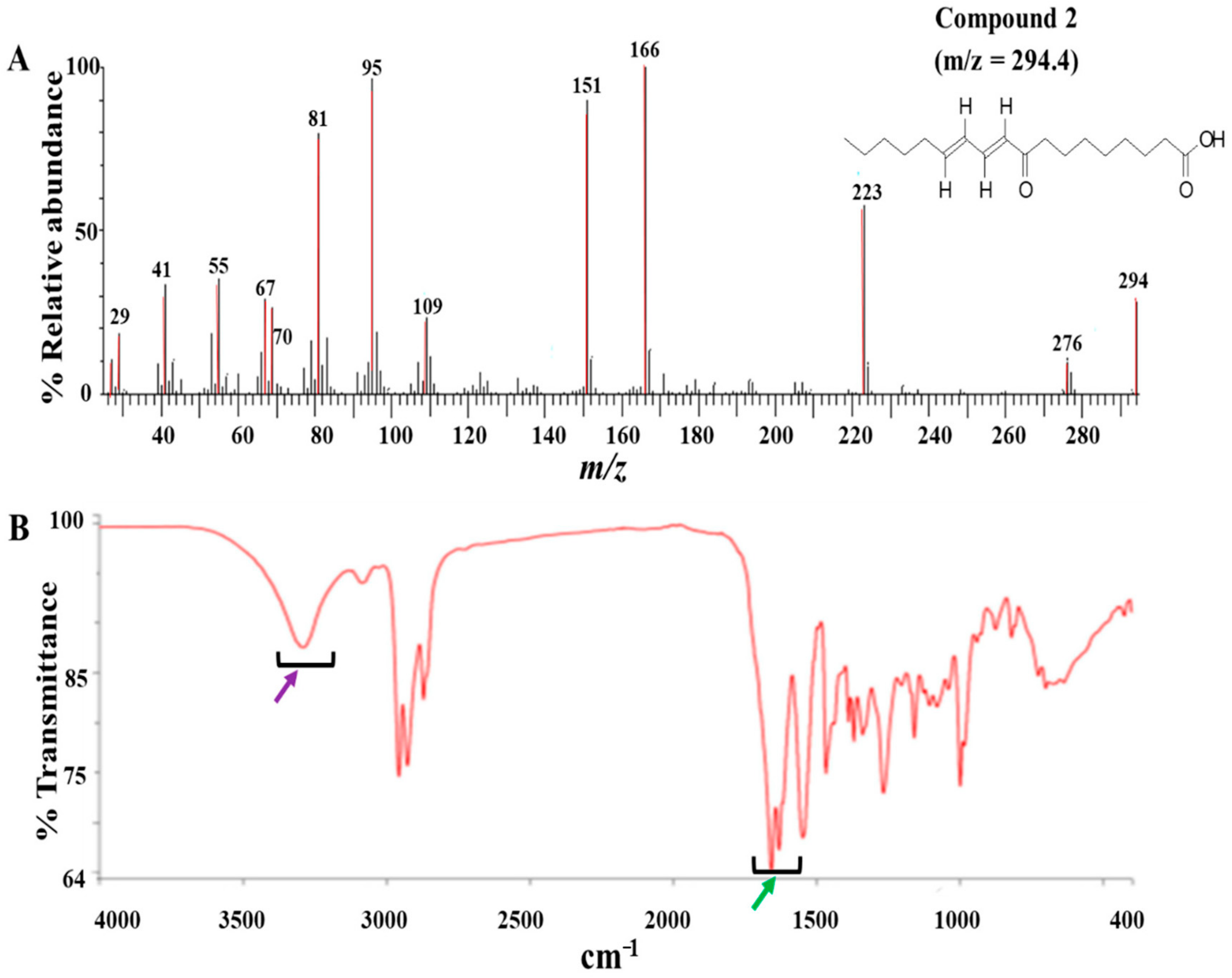
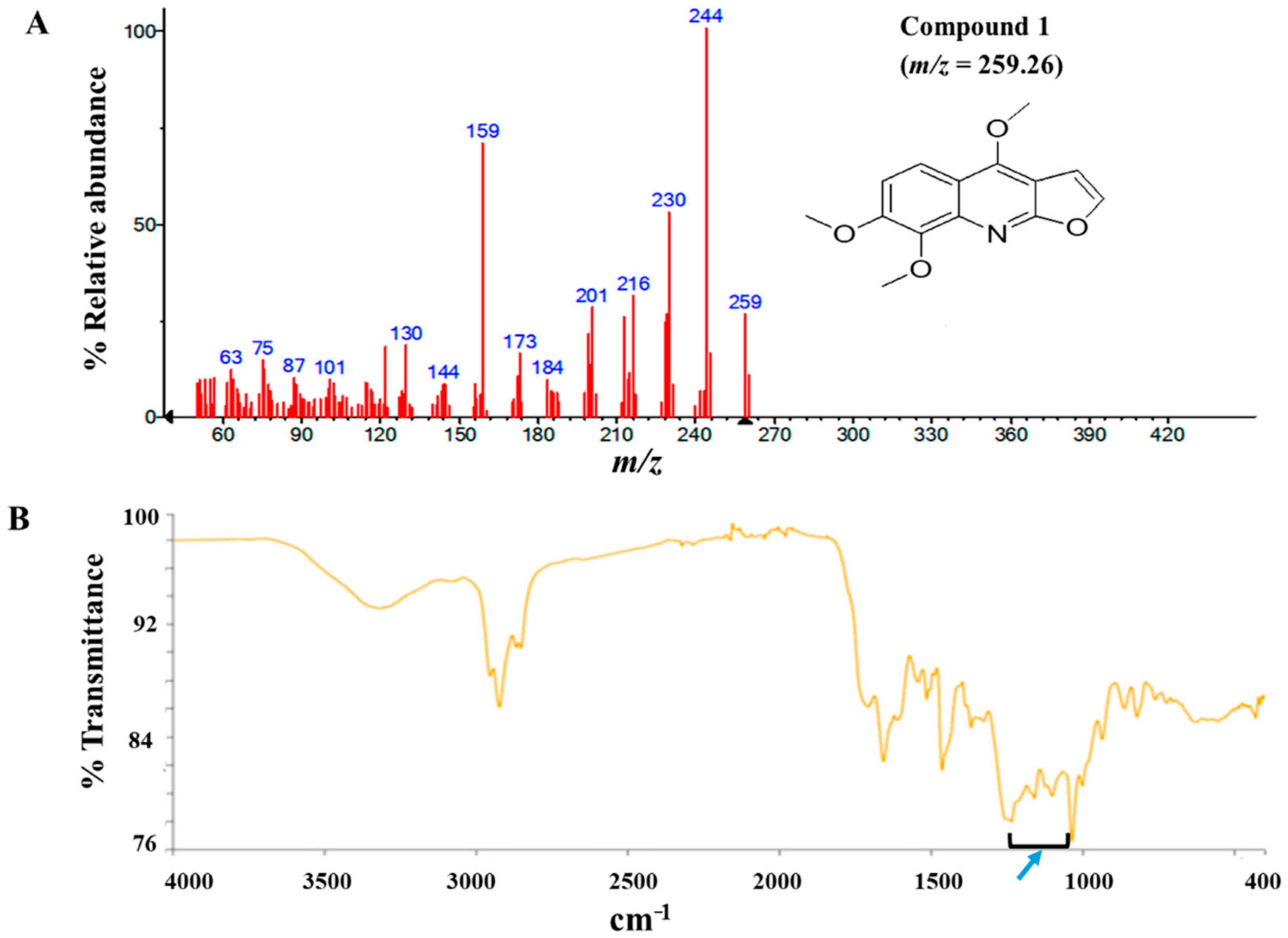


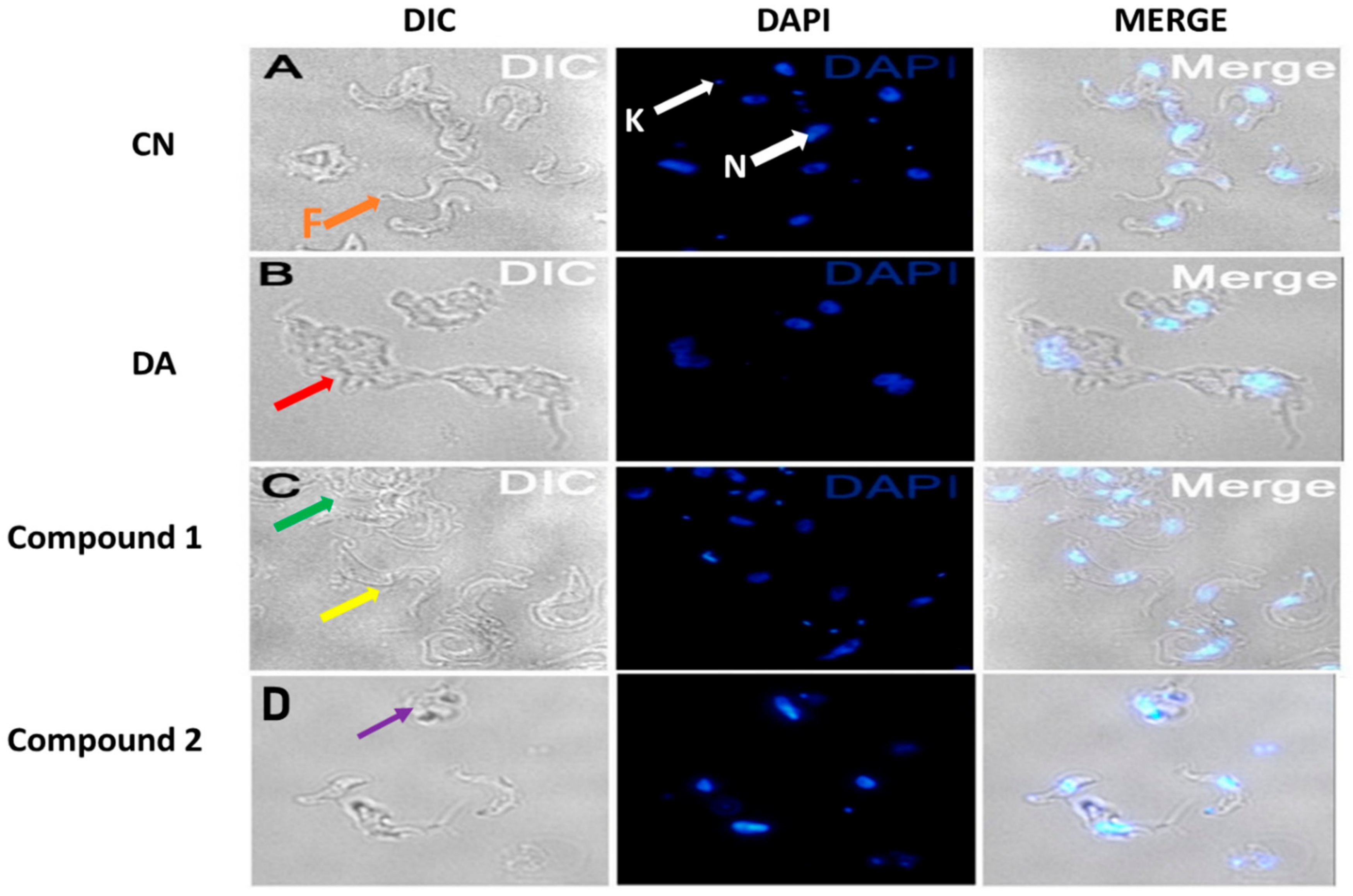
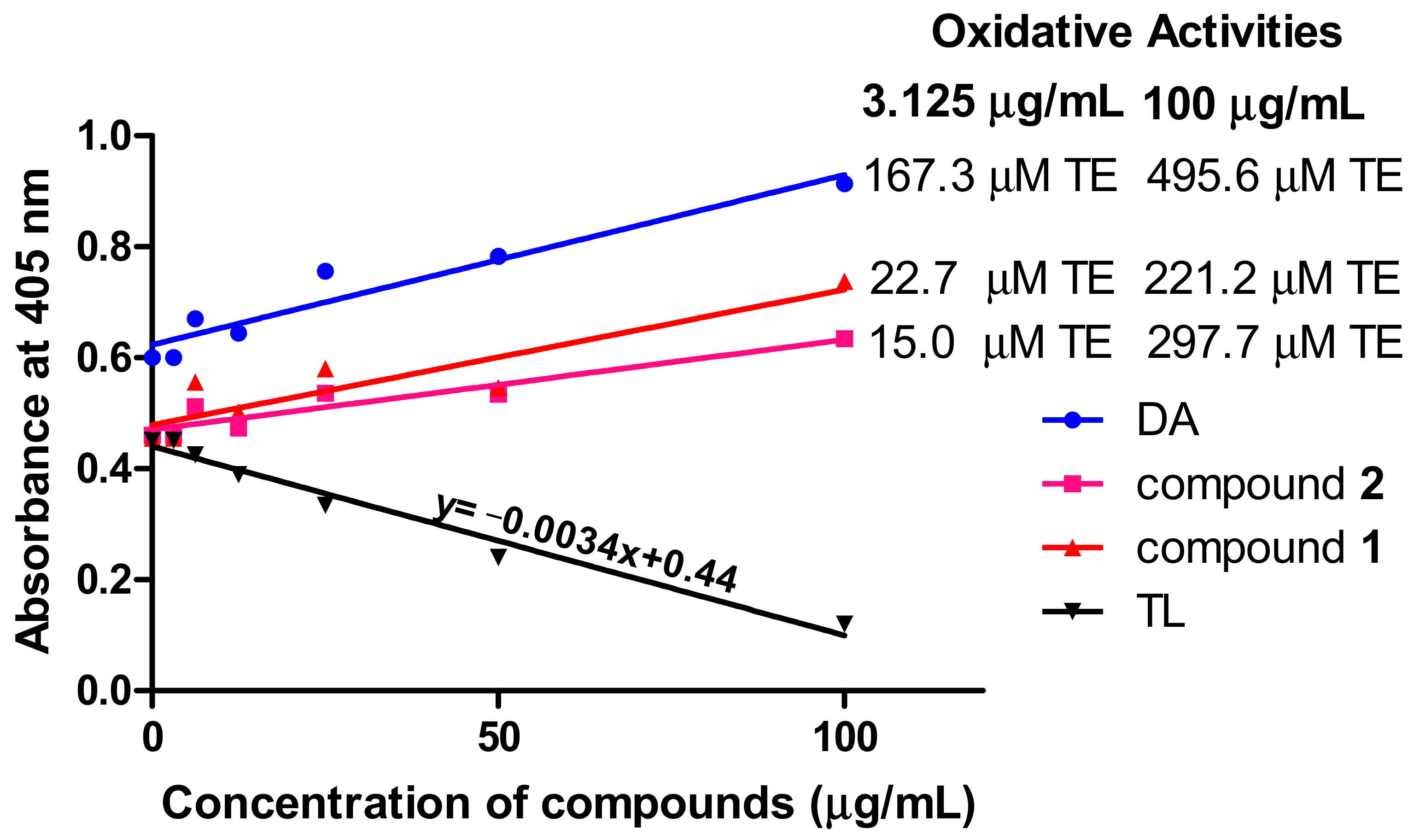
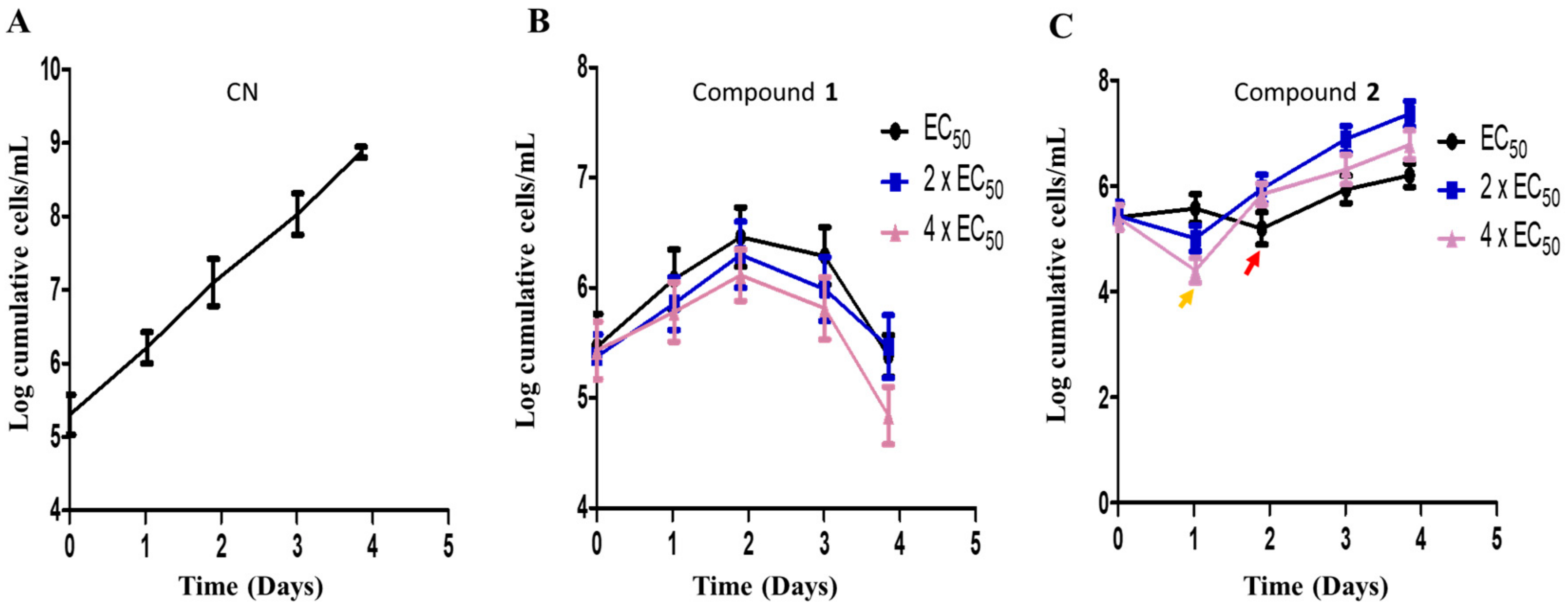
| Column Fractions | Mean EC50 ± SEM (μg/mL) |
|---|---|
| 1 | 11.2 ± 0.71 |
| 2 | 13.4 ± 0.47 |
| 3 | 9.3 ± 1.73 |
| 4 | 2.0 ± 0.20 |
| 5 | 6.2 ± 1.30 |
| 6 | 9.7 ± 1.23 |
| 7 | 17.2 ± 3.37 |
| 8 | 8.9 ± 0.74 |
| 9 | 19.5 ± 2.12 |
| 10 | 28.3 ± 1.06 |
| 11 | 54.5 ± 1.12 |
| DA | 0.5 ± 0.05 |
| Compounds | Mean EC50 ± SEM (μM) | SI | |
|---|---|---|---|
| T. brucei | RAW 264.7 | ||
| Compound 1 | 1.7 ± 0.14 | 127.3 ± 3.0 | 74.9 |
| Compound 2 | 1.2 ± 0.34 | 128.8 ± 2.3 | 107.3 |
| DA | 1.6 ± 0.07 | 138.7 ± 0.9 | 86.7 |
Publisher’s Note: MDPI stays neutral with regard to jurisdictional claims in published maps and institutional affiliations. |
© 2020 by the authors. Licensee MDPI, Basel, Switzerland. This article is an open access article distributed under the terms and conditions of the Creative Commons Attribution (CC BY) license (http://creativecommons.org/licenses/by/4.0/).
Share and Cite
Dofuor, A.K.; Ayertey, F.; Bolah, P.; Djameh, G.I.; Kyeremeh, K.; Ohashi, M.; Okine, L.K.; Gwira, T.M. Isolation and Antitrypanosomal Characterization of Furoquinoline and Oxylipin from Zanthoxylum zanthoxyloides. Biomolecules 2020, 10, 1670. https://doi.org/10.3390/biom10121670
Dofuor AK, Ayertey F, Bolah P, Djameh GI, Kyeremeh K, Ohashi M, Okine LK, Gwira TM. Isolation and Antitrypanosomal Characterization of Furoquinoline and Oxylipin from Zanthoxylum zanthoxyloides. Biomolecules. 2020; 10(12):1670. https://doi.org/10.3390/biom10121670
Chicago/Turabian StyleDofuor, Aboagye Kwarteng, Frederick Ayertey, Peter Bolah, Georgina Isabella Djameh, Kwaku Kyeremeh, Mitsuko Ohashi, Laud Kenneth Okine, and Theresa Manful Gwira. 2020. "Isolation and Antitrypanosomal Characterization of Furoquinoline and Oxylipin from Zanthoxylum zanthoxyloides" Biomolecules 10, no. 12: 1670. https://doi.org/10.3390/biom10121670





